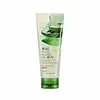What's inside
What's inside
 Key Ingredients
Key Ingredients

No key ingredients
 Benefits
Benefits

 Concerns
Concerns

 Ingredients Side-by-side
Ingredients Side-by-side

Water
Skin ConditioningHelianthus Annuus Seed Oil
EmollientEthylhexyl Palmitate
Emollient1,2-Hexanediol
Skin ConditioningPolyglyceryl-10 Myristate
Skin ConditioningArachidyl Alcohol
EmollientGlycerin
HumectantCetearyl Alcohol
EmollientButylene Glycol
HumectantBehenyl Alcohol
EmollientArachidyl Glucoside
EmulsifyingGlucose
HumectantCoco-Glucoside
CleansingGlyceryl Stearate
EmollientDioscorea Japonica Root Extract
Skin ConditioningHibiscus Esculentus Fruit Extract
Skin ConditioningNelumbo Nucifera Root Extract
Skin ConditioningUndaria Pinnatifida Extract
Skin ConditioningLaminaria Japonica Extract
Skin ProtectingGlycine Max Seed Extract
Skin ConditioningCocos Nucifera Fruit Extract
EmollientOryza Sativa Extract
AbsorbentPrunus Amygdalus Dulcis Seed Extract
Skin ConditioningAvena Sativa Meal Extract
SoothingCitric Acid
BufferingXanthan Gum
EmulsifyingSodium Polyacrylate
AbsorbentWater, Helianthus Annuus Seed Oil, Ethylhexyl Palmitate, 1,2-Hexanediol, Polyglyceryl-10 Myristate, Arachidyl Alcohol, Glycerin, Cetearyl Alcohol, Butylene Glycol, Behenyl Alcohol, Arachidyl Glucoside, Glucose, Coco-Glucoside, Glyceryl Stearate, Dioscorea Japonica Root Extract, Hibiscus Esculentus Fruit Extract, Nelumbo Nucifera Root Extract, Undaria Pinnatifida Extract, Laminaria Japonica Extract, Glycine Max Seed Extract, Cocos Nucifera Fruit Extract, Oryza Sativa Extract, Prunus Amygdalus Dulcis Seed Extract, Avena Sativa Meal Extract, Citric Acid, Xanthan Gum, Sodium Polyacrylate
Water
Skin ConditioningGlycerin
HumectantSodium Cocoyl Alaninate
Disodium Cocoyl Glutamate
CleansingXanthan Gum
EmulsifyingPEG-40 Hydrogenated Castor Oil
EmulsifyingAloe Barbadensis Leaf Extract
EmollientCentella Asiatica Extract
CleansingPolygonum Cuspidatum Root Extract
AntioxidantScutellaria Baicalensis Root Extract
AstringentCamellia Sinensis Leaf Extract
AntimicrobialGlycyrrhiza Glabra Root Extract
BleachingChamomilla Recutita Flower Extract
MaskingRosmarinus Officinalis Leaf Extract
AntimicrobialLauryl Hydroxysultaine
CleansingSodium Cocoyl Glutamate
CleansingPotassium Cocoyl Glycinate
Caprylyl Glycol
EmollientPotassium Cocoate
EmulsifyingCitric Acid
BufferingButylene Glycol
HumectantTrisodium EDTA
Sodium Benzoate
MaskingParfum
MaskingLinalool
PerfumingLimonene
PerfumingWater, Glycerin, Sodium Cocoyl Alaninate, Disodium Cocoyl Glutamate, Xanthan Gum, PEG-40 Hydrogenated Castor Oil, Aloe Barbadensis Leaf Extract, Centella Asiatica Extract, Polygonum Cuspidatum Root Extract, Scutellaria Baicalensis Root Extract, Camellia Sinensis Leaf Extract, Glycyrrhiza Glabra Root Extract, Chamomilla Recutita Flower Extract, Rosmarinus Officinalis Leaf Extract, Lauryl Hydroxysultaine, Sodium Cocoyl Glutamate, Potassium Cocoyl Glycinate, Caprylyl Glycol, Potassium Cocoate, Citric Acid, Butylene Glycol, Trisodium EDTA, Sodium Benzoate, Parfum, Linalool, Limonene
 Reviews
Reviews

Ingredients Explained
These ingredients are found in both products.
Ingredients higher up in an ingredient list are typically present in a larger amount.
Butylene Glycol (or BG) is used within cosmetic products for a few different reasons:
Overall, Butylene Glycol is a safe and well-rounded ingredient that works well with other ingredients.
Though this ingredient works well with most skin types, some people with sensitive skin may experience a reaction such as allergic rashes, closed comedones, or itchiness.
Learn more about Butylene GlycolCitric Acid is an alpha hydroxy acid (AHA) naturally found in citrus fruits like oranges, lemons, and limes.
Like other AHAs, citric acid can exfoliate skin by breaking down the bonds that hold dead skin cells together. This helps reveal smoother and brighter skin underneath.
However, this exfoliating effect only happens at high concentrations (20%) which can be hard to find in cosmetic products.
Due to this, citric acid is usually included in small amounts as a pH adjuster. This helps keep products slightly more acidic and compatible with skin's natural pH.
In skincare formulas, citric acid can:
While it can provide some skin benefits, research shows lactic acid and glycolic acid are generally more effective and less irritating exfoliants.
Most citric acid used in skincare today is made by fermenting sugars (usually from molasses). This synthetic version is identical to the natural citrus form but easier to stabilize and use in formulations.
Read more about some other popular AHA's here:
Learn more about Citric AcidGlycerin is already naturally found in your skin. It helps moisturize and protect your skin.
A study from 2016 found glycerin to be more effective as a humectant than AHAs and hyaluronic acid.
As a humectant, it helps the skin stay hydrated by pulling moisture to your skin. The low molecular weight of glycerin allows it to pull moisture into the deeper layers of your skin.
Hydrated skin improves your skin barrier; Your skin barrier helps protect against irritants and bacteria.
Glycerin has also been found to have antimicrobial and antiviral properties. Due to these properties, glycerin is often used in wound and burn treatments.
In cosmetics, glycerin is usually derived from plants such as soybean or palm. However, it can also be sourced from animals, such as tallow or animal fat.
This ingredient is organic, colorless, odorless, and non-toxic.
Glycerin is the name for this ingredient in American English. British English uses Glycerol/Glycerine.
Learn more about GlycerinWater. It's the most common cosmetic ingredient of all. You'll usually see it at the top of ingredient lists, meaning that it makes up the largest part of the product.
So why is it so popular? Water most often acts as a solvent - this means that it helps dissolve other ingredients into the formulation.
You'll also recognize water as that liquid we all need to stay alive. If you see this, drink a glass of water. Stay hydrated!
Learn more about WaterXanthan gum is used as a stabilizer and thickener within cosmetic products. It helps give products a sticky, thick feeling - preventing them from being too runny.
On the technical side of things, xanthan gum is a polysaccharide - a combination consisting of multiple sugar molecules bonded together.
Xanthan gum is a pretty common and great ingredient. It is a natural, non-toxic, non-irritating ingredient that is also commonly used in food products.
Learn more about Xanthan Gum